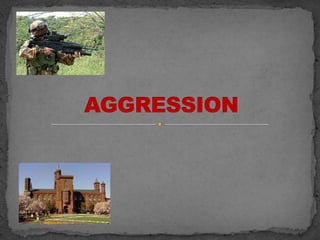Report
Share

Recommended
More Related Content
What's hot
What's hot (20)
Zimbardo's Experiment : The Stanford Prison Experiment

Zimbardo's Experiment : The Stanford Prison Experiment
The Stanford prison experiment: how our environment can affect our behaviour

The Stanford prison experiment: how our environment can affect our behaviour
Introduction to Social Psychology ( The Field of Social Psychology)

Introduction to Social Psychology ( The Field of Social Psychology)
Viewers also liked
Viewers also liked (15)
Deindividuation (Social psychological theories of aggression) A2

Deindividuation (Social psychological theories of aggression) A2
The role of neural and hormonal factors in aggression

The role of neural and hormonal factors in aggression
Similar to Institutional aggression A2
Similar to Institutional aggression A2 (16)
A-Level Psychology: Institutional Aggression - New Spec

A-Level Psychology: Institutional Aggression - New Spec
Bradford mvsu fall 2012 intro social structure (ch5)

Bradford mvsu fall 2012 intro social structure (ch5)
Bradford mvsu fall 2012 social problems lecture 1 short

Bradford mvsu fall 2012 social problems lecture 1 short
Management of Hostile Behaviour of Prison Inmates with Psychoactive Substance...

Management of Hostile Behaviour of Prison Inmates with Psychoactive Substance...
SYA 4010 Sociological TheoryAnalytical Essay – Outline Worksheet.docx

SYA 4010 Sociological TheoryAnalytical Essay – Outline Worksheet.docx
Unit 3. The Ethical Dimension of Human Existence.pptx

Unit 3. The Ethical Dimension of Human Existence.pptx
More from Jill Jan
More from Jill Jan (20)
AS Behaviourist treatments systematic desensitisation pp

AS Behaviourist treatments systematic desensitisation pp
Institutional aggression A2
- 2. QUIZ
- 3. What are institutions? Write down as many as you can think of! Aggression can occur WITHIN GROUPS or BETWEEN GROUPS... What do you think we mean by this?
- 4. Institutions are simply groups of people held together by a common factor They may be distinct entities, eg schools, prisons They may be distinct groups, eg police, army They may be less distinct groups, eg terrorist groups What examples of aggression can you think of for each of these institutions?
- 5. A survey of NHS services reported over 84,000 violent or abusive incidents on staff in 2000/01 (Department of Health 2002) 26,000 prisoner-prisoner assaults in US prisons (Wortley 2002)
- 6. Why do you think this behaviour occurs in institutions Take 5 minutes to jot down some ideas... STUCK? Think of the types of people, the situation and the environment!!
- 7. In pairs, brainstorm why people in prison may be aggressive
- 8. 1) Interpersonal factors- The importation model - Prisoners ‘import’ their attitudes, values ‘social histories’ and traits into the prison. (Irwin and Cressey 1962) - What influences do these have? - Write down the answer
- 9. Dispositional (individualistic ) causes This suggests that the behaviour is due to ‘a few bad apples’ and not due to the situation Therefore any aggression in prisons is due to the personalities of the individual inmates rather than the situation they have been put in General Myers, a chairman in the US Army state that the abuse at Abu Ghraib prison was not systematic abuse but in fact due to ‘rogue soldiers’
- 10. Classified prisoners into three subcultures through their values, attitudes and experiences THE CRIMINAL SUBCULTURE: • Follow the norms associated with being a thief or criminal • Values such as not betraying each other or being trustworthy amongst other criminals are important. THE CONVICT SUBCULTURE: • Have been raised in prison system • Look for positions of power or influence within the system • This group are most likely to turn to aggression • Influenced by deprivation prior to being imprisoned and bring values of that subculture inside with them. THE 'STRAIGHT' SUBCULTURE: • Tend to be one-time offenders • Weren't part of a criminal subculture before going inside • Rejects both other groups within prison and identify more with prison officers and staff • Tend not to be very aggressive whilst in prison.
- 11. 2) Situational factors- The Deprivation Model -says that the behaviour is the product of stressful/oppressive conditions of the institution itself- Paterline and Peterson 1999
- 12. Situational Forces Zimbardo claimed that many of the same psychological processes were found between the Stanford Prison Experiment and Abu Ghraib suggesting situational factors had a major impact of the behaviour of the guards However many studies do not support the deprivation model, showing pre-institutionalisation was the biggest predictor of inmate aggression regardless of the particular features of the institution
- 13. COME TO THE NEXT LESSON PREPARED WITH A NEWSPAPER ARTICLE/INTERNET SEARCH/WRITTEN DOCUMENT OF A RECENT INCIDENCE OF INSTITUTIONAL AGGRESSION PLEASE EXPLAIN IT USING THE CONCEPTS AND PROCESSES THAT WE HAVE LEARNED TODAY YOU WILL BE READING THEM OUT IN THE LESSON!!
